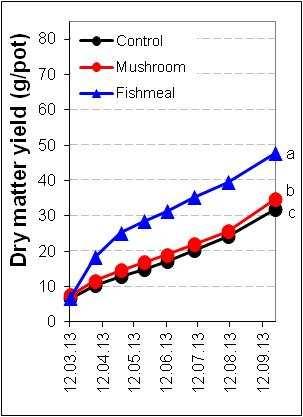
27 minute read
4.2 Basil experiment
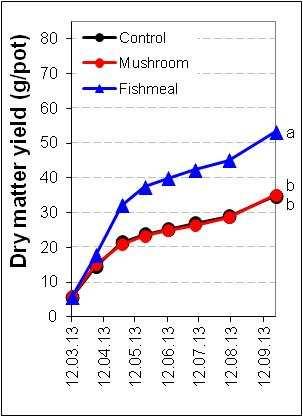
a b c
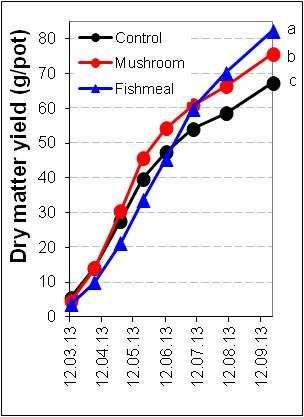
Fig. 9: Dry matter yield of ryegrass after application of organic fertilisers to different soils (a: 1,5% Nt, 21,4% Corg content, b: 0,6% Nt, 6,8% Corg content, c: 1,0% Nt, 12,8% Corg content. Ryegrass was grown 221 d at 60% maximum water holding capacity and shoots were harvested eight times.
Letters indicate significant differences at the end of the experiment (LSD, p≤0,05).
4.2 Basil experiment
The pot experiment was conducted to determine the availability of selected organicfertiliser N to basil.
4.2.1 Germination
Basil germinated when it was not fertilised (control) or when fertiliser was applied in the form of composted cow manure and mushroom compost. A fertiliser application of fishmeal, Pioner complete 6-1-3® and composted chicken manure resulted in only few germinated seeds that died, however.
Germination of seeds in the successful three treatments was about 90% (Fig. 10). At the end of the growth period no significant differences in germination were detected between the different treatments.
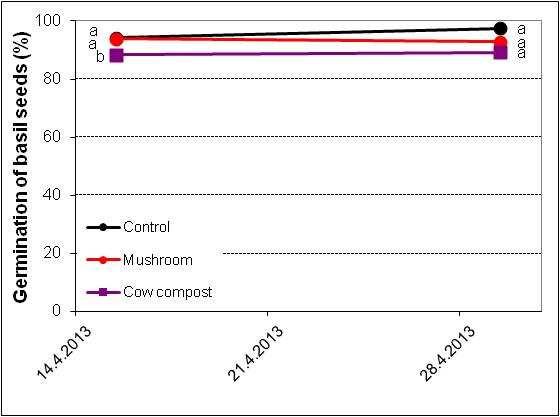
Fig. 10: Germination of basil after application of organic fertilisers.
Letters indicate significant differences (LSD, p≤0,05).
4.2.2 Height
Three and a half month after sowing was no difference between treatments in the height of basil measured. However, at the end of the growth period was basil significantly higher when fertilised with mushroom compost compared to the control, whereas no significant differences were found to composted cow manure (Fig. 11).
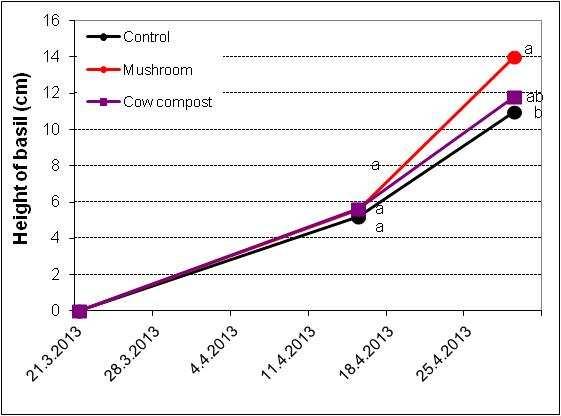
Fig. 11: Height of basil after application of organic fertilisers.
Letters indicate significant differences (LSD, p≤0,05).
4.2.3 Fresh yield
Treatments did not differ in fresh weight of basil at first harvest, when only the yield of basil was considered. However, when also the yield of the weeds was included, fresh weight was significantly higher with composted cow manure. Yield increased in all treatments markedly from first harvest to second harvest. When only the yield of basil was included, a significantly higher yield was measured with mushroom compost. However, when also the yield of weeds was included, a significantly higher yield was reached with mushroom compost and composted chicken manure compared to the unfertilised control (Fig. 12).
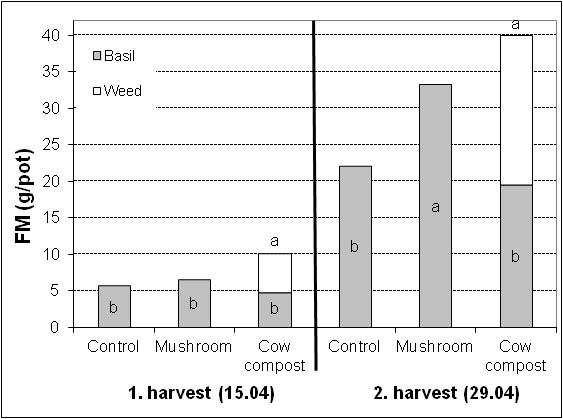
Fig. 12: Development of fresh weight of basil until marketable size after application of organic fertilisers.
Letters indicate significant differences (LSD, p≤0,05).
4.2.4 Dry yield
Dry weight of basil was not different between treatments at first harvest and also not when the dry matter yield of the weeds was included. Dry matter yield increased in all treatments markedly from first harvest to second harvest. When only yield of basil was included, a significantly higher yield was measured with mushroom compost than with composted cow manure. However, when also the yield of weeds was included, increased the dry weight significantly with mushroom compost and composted chicken manure compared to the unfertilised control (Fig. 13).

Fig. 13: Development of dry weight of basil until marketable size after application of organic fertilisers.
Letters indicate significant differences (LSD, p≤0,05).
4.2.5 Apparent N utilisation
Apparent N utilisation of organic fertilisers was low and no significant differences between fertiliser treatments were calculated at the end of the growth period (Fig. 14).
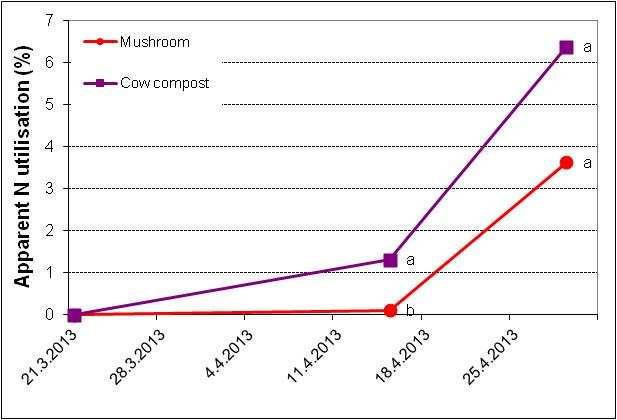
Fig. 14: Apparent N utilisation of organic fertilisers by basil and weeds. Basil was grown 39 d until marketable size.
Letters indicate significant differences at the end of the experiment (LSD, p≤0,05).
4.3 Greenhouse experiment
4.3.1 Marketable yield
The yield of tomatoes included all harvested red fruits at the end of the growth period. The fruits were classified in 1. class (> 55 mm), 2. class (45-55 mm) and not marketable fruits (too little fruits (< 45 mm), fruits with blossom end rot, flawed, cracked and not well shaped fruits). The yield of sweet pepper included all harvested red and green fruits. The fruits were classified in 1st class fruits (> 100 g/fruit) and not marketable fruits (fruits with too little weight (< 100 g), fruits with blossom end rot, fruits with damage from lighting, not well shaped fruits).
At the beginning of the growth period had all treatments a comparable yield. But, after two months of harvest of tomatoes and one month of harvest of sweet pepper, it seems that yield differences between treatments did increase. However, at the end of the harvest period was the yield level of marketable fruits low and the yield differences within the fertilised treatments not significant. Yield obtained with the
tested organic fertilisers was comparable to mushroom compost for both tomatoes and sweet pepper (Fig. 15, Fig. 16). Even yield in the unfertilised control was high (compared to the fertilised treatments) and with no statistically significances to the fertilised treatments, indicating a high soil N supply. The yield of sweet pepper with undersowing of clover was tendentially decreased, whereas this effect was not observed with tomatoes. It has to be mentioned, that due to a problem with aphids in sweet pepper the plants stayed for a long time very small, while the clover was developing well. In contrast, in tomatoes no pest problem was observed and the tomato plants were growing fast and suppressing the growth of the clover.
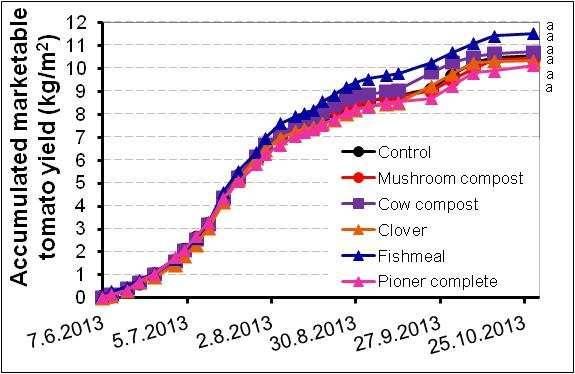
Fig. 15: Time course of accumulated marketable yield of tomatoes (1. and 2. class fruits) during seven months of growth period after application of organic fertilisers.
Letters indicate significant differences at the end of the experiment (LSD, p≤0.05).
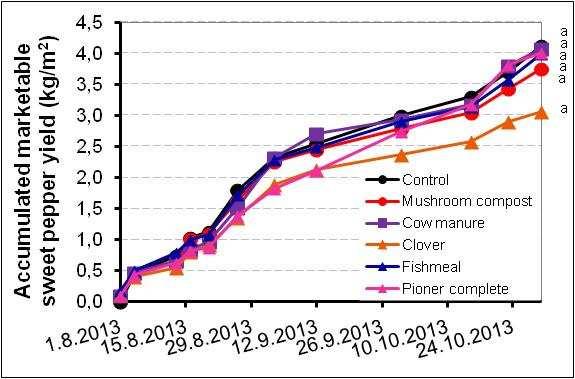
Fig. 16: Time course of accumulated marketable yield of sweet pepper (1. class fruits) during seven months of growth period after application of organic fertilisers.
Letters indicate significant differences at the end of the experiment (LSD, p≤0.05).
Number of marketable fruits was not different between the fertiliser treatments (Tab. 3).
Tab. 3: Cumulative total number of marketable tomatoes and sweet pepper at different fertiliser treatments. Number of marketable fruits
Treatment
1. class tomatoes 2. class tomatoes
1. class sweet pepper Control 43 a 43 a 20 a Mushroom compost 46 a 46 a 18 a Cow manure 41 a 41 a 21 a Clover 44 a 44 a 16 a Fishmeal 47 a 47 a 19 a Pioner complete 6-1-3® 42 a 42 a 19 a
Letters indicate significant differences at the end of the harvest period (HSD, p ≤ 0,05).
Average fruit size of first class tomatoes was varying between 80-110 g / fruit (Fig. 17) and for sweet pepper between 160-280 g / fruit (Fig. 18). For tomatoes there seems to be no difference between the fertiliser treatments, while for sweet pepper the treatment “clover” and “cow manure” seems to be with a lower average sweet pepper weight and Pioner complete 6-1-3® with a higher fruit weight.
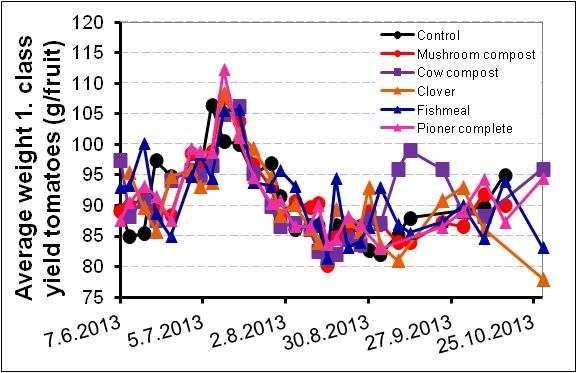
Fig. 17: Average fruit weight of tomatoes at different fertiliser treatments.
Fig. 18: Average fruit weight of sweet pepper at different fertiliser treatments. 26
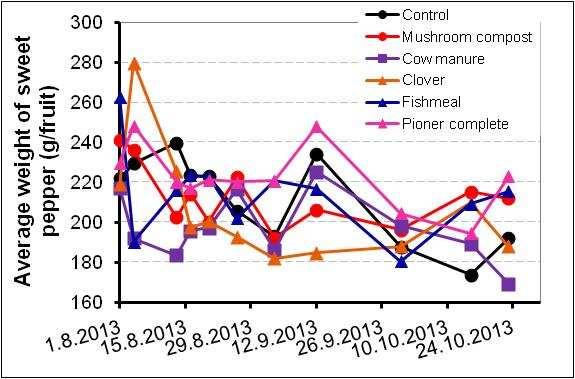
4.3.2 Outer quality of yield
Marketable yield was more than 80% for tomatoes (Tab. 4) and around 90% for sweet pepper (Tab. 5). Unmarketable fruits were mainly because of too small tomato fruits and not well shaped sweet pepper fruits.
Tab. 4: Proportion of marketable and unmarketable tomato yield at different fertiliser treatments.
Treatment
Marketable yield (%) Unmarketable yield (%)
1. class 2. class too little weight flawed Control 32 51 17 0 Mushroom compost 34 48 17 1 Cow compost 30 54 15 1 Clover 34 50 15 1 Fishmeal 33 52 14 1 Pioner complete 6-1-3® 32 49 18 1
Tab. 5: Proportion of marketable and unmarketable sweet pepper yield at different fertiliser treatments.
Treatment Marketable yield (%)
1. class (> 100 g)
_______ Unmarketable yield (%) ________
too little weight stilrot damage from lighting
not well shaped Control 92 0 1 0 7 Mushroom compost 92 2 1 1 4 Cow compost 88 2 1 0 9 Clover 89 2 0 4 5 Fishmeal 95 2 0 0 3 Pioner complete 6-1-3® 93 2 0 0 5
4.3.3 Interior quality of yield
4.3.3.1 Sugar content
Sugar content of tomatoes and sweet pepper was measured two times during the harvest period and varied between 3,7 and 4,5 °BRIX for tomatoes (Fig. 19) and between 6,3 and 7,4 °BRIX for sweet pepper (Fig. 20). Sugar content of tomatoes and sweet pepper increased with longer harvest period except for the treatment “control” and “Pioner complete 6-1-3®” for tomatoes.
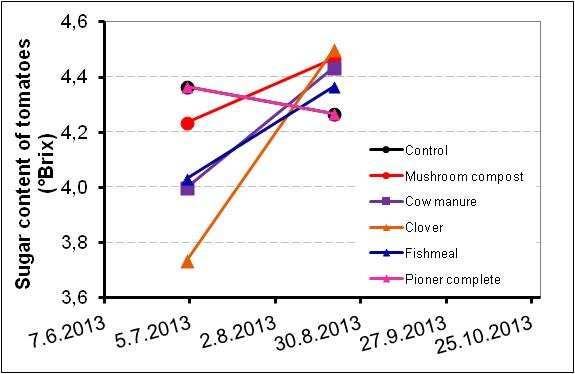
Fig. 19: Sugar content of tomatoes at different fertiliser treatments.
Fig. 20: Sugar content of sweet pepper at different fertiliser treatments.
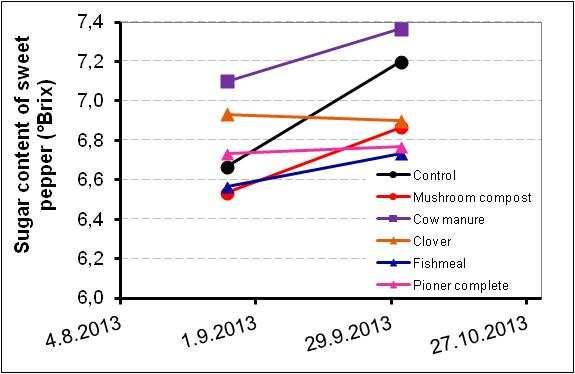
4.3.3.2 Nitrogen content of fruits
Nitrogen content of tomatoes and sweet pepper was measured two times during the harvest period. N content varied between 2,0-2,5% for tomatoes (Fig. 21) and 2,4-2,8% for sweet pepper (Fig. 22).

Fig. 21: N content of tomato fruits at different fertiliser treatments.
Fig. 22: N content of red sweet pepper fruits at different fertiliser treatments. 29

4.3.4 Soil nitrate content
Fertiliser application markedly affected the nitrate content in the 0-15 cm layer. In the control treatment, nitrate content was relatively high (compared to the fertiliser treatments). Type of fertiliser and hand hoeing strongly influenced the nitrate content in the soil. Hand hoeing generally increased the soil nitrate content (see unfertilised control) except in the last sampling dates for tomatoes. In general, the soil nitrate content was higher in the soil where tomatoes were grown compared to sweet pepper.
A fertiliser application increased generally soil nitrate content in soil. In sweet pepper, the increase in soil nitrate content was highest after the application of fishmeal and Pioner complete 6-1-3®. However, this effect was much less obvious in tomatoes and especially less pronounced with fishmeal. For sweet pepper, after peak values of around 8 g NO3 --N / m2 decreased nitrate content. With each fertiliser application the decline was getting less and decreased from 0 to 4 to 8 g NO3 --N / m2 and finally to about 12 g NO3 --N / m2 and stayed at the latter value for two months until the end of the experiment. For tomatoes, after peak values of around 40 g NO3 --N / m2 decreased nitrate content to nearly 10-30 g NO3 --N / m2 with a reduction in soil nitrate content at the end of the experiment when the last sampling date of fishmeal is excluded.
Composted cow manure and the reference fertiliser mushroom compost increased the soil nitrate content much less compared to the previous mentioned fertilisers. Values of mostly 10-30 g NO3 --N / m2 were reached in tomatoes and 2-8 g NO3 --N / m2 in sweet pepper.
The treatment with undersowing of clover showed an even lower soil nitrate content than the unfertilised control and amounted most of the time around 10 g NO3 --N / m2 in tomatoes and 2 g NO3 --N / m2 in sweet pepper.
Finally, at the end of the greenhouse experiment soil nitrate content of all treatments was not much different compared to the soil nitrate content measured two months before, excluding fishmeal and Pioner complete 6-1-3® in the tomato experiment.
) -N / m 2 Soil nitrate content (g NO 3
50
40
30
20
10
0 9.4.2013 7.5.2013 4.6.2013 2.7.2013 30. 7.2013 27.8.2013 24. 9.2013 22.10.2013
1. fertilizer application 2. fertilizer application 3. fertilizer application 4. fertilizer application
Control Cow Fishmeal Mushroom Pioner complete Clover
Fig. 23: Soil nitrate content in tomatoes after the split application of different organic fertilisers in the glasshouse. Fertiliser was applied within a 30 cm wide fertiliserband and thereafter all treatments were hand hoed 5-10 cm deep.
Fig. 24: Soil nitrate content in sweet pepper after the split application of different organic fertilisers in the glasshouse. Fertiliser was applied within a 30 cm wide fertiliserband and thereafter all treatments were hand hoed 5-10 cm deep.
2 ) Soil nitrate content (g NO 3 -N / m
20
16
12
8
4
0
1. fertilizer application
17.4.2013 15. 5.2013 12. 6.2013 10. 7.2013 7.8.2013 4.9.2013 2.10.2013 30.10.2013
2. fertilizer application 3. fertilizer application 4. fertilizer application
Control Cow Fishmeal Mushroom Pioner complete Clover
5 DISCUSSION
5.1 Effect of fertiliser
The tested organic fertilisers differed strongly with regard to apparent N utilisation of ryegrass in the pot experiment and in soil N mineralisation in the greenhouse experiment with tomatoes and sweet pepper. This confirms earlier experiments with organic fertilisers (Schmitz and Fischer, 2003, Stadler et al. 2006). Gutser et al., (2005) stated that N availability from organic fertilisers determined as mineralfertiliser equivalents vary typically between 30-70% in the year of application.
N release was described by the N content and the C : N ratio of the tested fertilisers, even though with a low correlation and some fertilisers did not fit in the observed relationship. The slightly poorer performance of the N content with respect to C : N ratio in predicting the N release of the fertilisers could be ascribed to the relatively high N content of fishmeal. However, a close relationship between the above mentioned fertiliser characteristics and their N mineralisation was found by Stadler et al. (2006) and Iritani and Arnold (1960) suggesting that fertiliser N content and C : N ratio is a suitable indicator for predicting the N release of organic fertilisers, provided the fertiliser characteristics are sufficiently different (Stadler et al., 2006).
The total N utilisation of mushroom compost was quite low. A comparable N utilisation was reached with cow, sheep and horse manure. Therefore, mushroom compost can be replaced by the mentioned composted animal fertiliser. However, due to missing animal husbandry for most vegetable producers, animal manure is lacking, but manure could be used from organic animal production or from conventional production after composting.
In general, composted animal manure and plant compost are characterised by a low N content and a relatively high C : N ratio, resulting in a low and slow N mineralisation. Therefore, traditional compost is not a real fertiliser, but mainly used as soil conditioner and it will also mineralise nitrogen in low amounts months after application. Furthermore, the weed potential in compost needs to be kept down.
When a faster (compared to compost) and steadier mineralising fertiliser is needed, growers could use milled fababeans. However, fababeans have not been grown in Iceland and must therefore be imported. But, it would be possible to replace fababeans by in Iceland grown lupins, when their seeds would be gathered and
milled. It can be assumed that icelandic lupins have a comparable N content and C : N ratio than fababeans and consequently similar N mineralisation.
Comparable to fababeans acted chicken compost. In contrast to the other animal composts, chicken compost had a slightly lower C : N ratio (but similar N content) and resulted in a higher N utilisation. However, chicken manure is only available from conventional production when needed in big amounts. The composted organic chicken manure that has been used in the experiment was from an organic grower that is holding some hens for private use.
If vegetable requires N very soon, it is recommended to apply either the fast mineralising fishmeal or Pioner complete 6-1-3® even though this fluid fertiliser is not in line with the general principle of organic horticulture to feed the plants through the soil. The success of using cuttings from clover for N application is depending much on the N content as well as the C : N ratio of the clover and results presented here might not be transferred when the characteristics of the clover differ.
The apparent N utilisation of mushroom compost and cow manure was both in the pot and basil experiment low, and numbers were comparable within experiments. The applied N amount was according to recommendations and only a much higher N amount (visible at 1.200 mg/l, but much more obvious at 1.600 mg/l soil) resulted in experiments in germination inhibition (Beck et al., 2005). For grain legumes is however a germination inhibition known and therefore it is recommended to wait after fertiliser application two weeks before sowing is done (Schmitz & Fischer, 2003).
The N mineralisation of the fertilisers in the tomato and sweet pepper experiment showed a similar pattern as in the pot experiment, where fishmeal and Pioner complete 6-1-3® resulted in higher peaks in N mineralisation compared to the other tested fertilisers. But this was not transferred into yield. The yield level was in general low which was caused by the relatively low natural solar irradiation during the whole growth period compared to other years with normally much higher natural solar irradiation. Yield of tomatoes and sweet pepper was comparable between organic fertilisers and the reference fertiliser mushroom compost, pointing out their ability for substitution. Moreover, for both crops the application of fertilisers did not significantly increase yield compared to the unfertilised control, indicating a high N supply of the soil. Also, Tourte et al. (2000) found no significant differences in the yield of marketable tomatoes between the control and an application of approx. 175 kg N/ha
in form of woolypod vetch. This might be explained by the often marginal effect of green manure on yield of tomatoes on fertile soils, but its high effects on poor soils (Thönnissen et al., 2000a), which was also observed by Stadler (2006). The tendentially lower yield of the clover treatment in the sweet pepper experiment can be transferred to a problem with aphids, resulting in plants that stayed long very small, while the clover developed very well. In contrast, in tomatoes no pest problem was observed and the fast growing tomato plants were suppressing the growth of the clover.
5.2 Effect of soil
Soils in horticulture vary in their characteristics and therefore it was tested if there are potential interactions between fertilisers and soils. Attention was payed on different soil Nt and Corg contents while the soil texture was not examined. However, it is known that the soil texture is also influencing fertiliser N mineralisation even though this effect is minor compared to the role of the N content of organic fertilisers (Stadler et al., 2006). In the present experiment was also a soil effect on the mineralisation of the tested organic fertilisers observed. In one soil occurred an immobilisation of N with nearly all fertilisers. With fertilisers high in N content did this immobilisation even get stronger with longer growing period and it took a long time until the positive effect of e.g. fishmeal developed. However, at the end had all soils the same fertiliser order. The behaviour of the fertilisers could not be explained with the soil Nt and Corg contents which is in line with Whitehead (1984) who observed that the apparent N utilisation of 15N labelled ammonium nitrate by ryegrass in 21 soils ranged between 45-67%, but was not related to soil Corg content. Similarly, Legg and Stanford (1967) showed that the fertiliser N uptake (15NO3 -) by oat on 12 surface greenhouse soils ranging from 0.5-3.9% C was also not related to soil Corg content. Also, Stadler et al. (2006) and Bending et al. (2002) stated that no clear influence of OM could be demonstrated. In the literature is described that soil characteristics influenced N mineralisation more strongly for fertilisers with lower N content (Stadler et. al., 2006). However in the presented findings acted fertilisers higher in N content more different in soils than fertilisers with a lower N content.
It is known that in the soil where the N immobilisation occurred, was mushroom compost regularly applied. Consequently, the soil increased in total OM and
mineralisable N (Power and Doran, 1984). The turnover of the organic substance might affect the N utilisation of organic fertilisers on different soils. Soils with a high OM turnover are thought to have a large pool of labile, decomposable C and a smaller pool of stable, texture dependent C (Rühlmann, 1999). Furthermore, N turnover of OM added to soil in crop residues and manure affects the availability of N mineralised from both added and native soil OM (Thomsen et al., 2003).
The N release by the soils was not obviously related to their soil Corg contents. Possibly the soil with the N immobilisation was not able to deal with readily available N in the form of e.g. fishmeal and Pioner complete 6-1-3® due to already much available N from fertiliser applications the years before and consequently immobilised the newly applied fertiliser instead. Stadler (2006) observed that for straw (1,5% N) and pea (3,7% N) was the N immobilisation of straw and the lower apparent N utilisation of pea were more pronounced in the higher Corg content soils. In the literature is this immobilisation also related to the soil texture: Soils that were high in silt and clay immobilised more N from crop residues (1,3-2,8% N) than did sandy soils (Egelkraut et al., 2000). Moreover, remineralisation of immobilised N shows a greater delay in soils with a higher clay content (Whitmore and Groot, 1997; Egelkraut et al., 2000). Net mineralisation in fine textured soils is assumed to be lower, because the OM is physically protected against decomposition (Hassink, 1992).
Magdoff (1991) obtained the highest amounts of available N from soils with medium Nt and Corg content. He explained this result by the fact that at low OM contents, the mineralisation rate was high, but less N was available due to low contents of organic N. And soils high in Nt and Corg had low mineralisation rates which consequently resulted in low amounts of mineralised N as well. This might explain the high N mineralisation (unfertilised control) observed here in “soil higher Corg”. The mineralisation in this soil was markedly superior to those of the two other soils, regardless of whether their Corg contents were higher or lower.
Magdoff (1978) concluded that soils with a high mineralisation rate of soil OM may also rapidly mineralise N from manure and in a soil with a low soil N mineralisation rate manure N release will be lower. Our studies indicate that soils with a high N release will not necessarily result in a high apparent N utilisation of the fertilisers.
5.3 Fertiliser application strategies
The data from the pot experiment indicate that N mineralisation of organic fertilisers increased rapidly and was mostly completed after 10-11 weeks after application and declined thereafter. Therefore, the time course of the N release of these fertilisers may favourably match the early N demand of tomatoes and sweet pepper. On the other hand, if the whole N amount of fertiliser is applied at planting there will be a high N surplus during the early tomato and sweet pepper growth. But, mineral N in soil may be prone to losses by leaching or immobilisation (Blankenau and Kuhlmann, 2000). Hence, it might be expected that a split application of organic fertilisers could be favourable for long-growing crops.
The efficiency of the fertiliser on yield depends largely on the synchrony between N release of crop residues and N demand by the growing crop (Iritani and Arnold, 1960). The time course of N uptake markedly differs between vegetable crops (Matsumoto et al., 1999) and for tomatoes N uptake, measured by the difference of NO3 in the soil in the planted vs. unplanted plots, starts 1-3 weeks after planting (Thönnissen et al., 2000b). According to the pot experiment can from both fishmeal and Pioner complete 6-1-3® a high and rapid N release be expected that may temporarily exceed the N requirement of the tomato and sweet pepper plants, which is the reason why a splitted fertiliser strategy was selected to reduce intermittently occurring N excess in soil. However, on the one hand any surplus of mineral N in soil may be prone to losses by leaching or immobilisation (Blankenau and Kuhlmann, 2000). On the other hand a minimum content of mineral N in soil is needed to support a proper plant growth (Feller and Fink, 2002). In the glasshouse experiments residual NO3 --N remained in the soil at the end of the growing period of the tomatoes and sweet pepper, showing that there was no limitation of N at the end of the cropping season. However, at the second fertiliser application date, were nitrate values in the soil quite low and it would have been appropriate to apply fertiliser earlier.
In view of the missing yield differences, the N supply of the tomatoes and sweet pepper was obviously not significantly different between different treatments during crucial stages of development. Especially after each Pioner complete 6-1-3® application mineral N content was boosted by a high short-term N release. Similar results observed Båth (2001), where a late application of green manure (clover)
caused a delay in growth and N uptake of leek and high values of nitrate in soil at harvest.
Fishmeal and Pioner complete 6-1-3® acted as rapid N sources, ensuring a sufficient N supply for vegetable crops in organic horticulture. During the vegetation period a regular hoeing of the formerly fertilised plots will generally increase N mineralisation and should therefore be part of an optimised fertiliser management strategy.
5.3 Economics
Beside the effect of the fertiliser also the economic side is of interest. Table 6 shows the price per kg or l of fertiliser. Mushroom compost is about 6 times cheaper than fishmeal and about 3 times cheaper than Pioner complete 6-1-3®. However, one must keep in mind that a much higher amount of fertiliser in the form of mushroom compost is necessary to get 1 kg N compared to the other fertilisers. Also, the N utilisation was much lower with mushroom compost. Paying attention to the apparent N utilisation that was about 10% for mushroom compost would mean that one kg of mineralised N would nearly cost 3.000 ISK. For fishmeal with 75% apparent N utilisation it would be about 2.200 ISK and for Pioner complete 6-1-3® with 85% apparent N utilisation about 2.500 ISK. That means, according to the N utilisation would mushroom compost be the most expensive fertiliser. However, it also needs to taken into account that mushroom compost is releasing N not only in the year of application. Considering also the following years would then probably lead to similar values as for the other fertilisers. Therefore, on the one hand, mushroom compost cannot be classified as cheap fertiliser and on the other hand fishmeal and Pioner complete 6-1-3® cannot be classified as expensive fertilisers.
Tab. 6: Costs of organic fertilisers. Fertiliser size ISK / size (without VAT) N content (%) (mg/l) * ISK / kg ISK / l * ISK / kg N ISK / l * N
Mushroom compost 1 m3 2500 1,91 6
(bulk density: 450 kg/m3) 291
Fishmeal 1 kg 185 10,94 185 1691 Pioner complete 6-1-3® 20 l 9 336 216 * 457 864
(ready mixture)
6 CONCLUSIONS
In the year of application are organic fertilisers mineralising from 10% (compost) up to 80% (fishmeal, Pioner complete 6-1-3®) of the total N applied. Consequently, it can be assumed that the regular application of these fertilisers over several years will tend to increase total soil OM and N that can potentially be mineralised. It should therefore be kept in mind whether long-term application of these fertilisers may require a modified application strategy.
The prohibition of using mushroom compost should not really effect the organic vegetable growers as there are at least equal (composted animal manures) or even better fertilisers (e.g. fishmeal) that have a similar price on the market.
7 REFERENCES
BÅTH B, 2001: Nitrogen mineralisation and uptake in leek after incorporation of red clover strips at different times during the growing period. Biol. Agric. Hort. 18, 243-258.
BECK M, JAKSCH T, HENNING V, 2005: Düngung von Bio-Topfkräutern. Gemüse 8, 14-16
BENDING GD, TURNER MK, JONES JE, 2002: Interactions between crop residue and soil organic matter quality and the functional diversity of soil microbial communities. Soil Biol. Biochem. 34, 1073-1082.
BLANKENAU K, KUHLMANN H, 2000: Effect of N supply on apparent recovery of fertiliser N as crop N and Nmin in soil during and after cultivation of winter cereals. J. Plant Nutr. Soil Sci. 163, 91-100.
CORBEELS M, O´CONNELL AM, GROVE TS, MENDHAM DS, RANCE SJ, 2003:
Nitrogen release from eucalypt leaves and legume residues as influenced by their biochemical quality and degree of contact with soil. Plant Soil 250, 15-28.
EGELKRAUT TM, KISSEL DE, CABRERA ML, 2000: Effect of soil texture on nitrogen mineralised from cotton residues and compost. J. Environ. Qual. 29, 1518-1522.
FAO (1998): World Reference Base for Soil Resources, FAO, Rome.
FELLER C, FINK M, 2002: NMIN target values for field vegetables. In: Booij, R.,
Neeteson, J. (ed.): Acta Hort. 571, Proceedings of the ISHS workshop: Towards an ecologically sound fertilisation in field vegetable production, International
Society for Horticultural Science, 195-201.
GUNNLAUGSSON B, 1995: Sveppamassi sem áburðargjafi í lífrænni ylræktun –
Forathugun 1995. Garðyrkjufréttir nr 195.
GUNNLAUGSSON B, 1997: Sveppamassi sem áburðargjafi í lífrænni ylræktun.
Garðyrkjufréttir nr 201.
GUNNLAUGSSON B, GUÐFINNSSON GK, 2004: Lífrænir áburðargjafar í gúrkuræktun. Garðyrkjufréttir nr 214.
GUTSER R, EBERTSEDER T, WEBER A, SCHRAML M, SCHMIDHALTER U, 2005:
Shortterm and residual availability of nitrogen after long-term application of organic fertilisers on arable land. J. Plant Nutr. Soil Sci. 168, 439-446.
HASSINK J, 1992: Effects of soil texture and structure on carbon and nitrogen mineralisation in grassland soils. Biol. Fertil. Soils 14, 126-134.
HEUBERGER H, KREUZMAIR A, WEH F, VON TUCHER S, SCHNITZLER WH, 2005: Vegetabile Dünger als Stickstoffquelle für Topfbasilikum. - Freisetzung und
Aufnahme von Stickstoff aus vegetabilen Düngern bei Basilikum (Ocimum basilicum L.) in Topfkultur. Zeitschrift für Arznei- und Gewürzpflanzen10 (3), 140143.
IRITANI WM, ARNOLD CY, 1960: Nitrogen release of vegetable crop residues during incubation as related to their chemical composition. Soil Science 89, 74-82.
JENSEN ES, 1994: Mineralisation-immobilisation of nitrogen in soil amended with low C:N ratio plant residues with different particle sizes. Soil Biol. Biochem. 26 (4), 519-521.
LEGG JO, STANFORD G, 1967: Utilisation of soil and fertiliser N by oats in relation to the available N status of soils. Soil Sci. Soc. Amer. Proc. 31, 215-219.
MAGDOFF FR, 1978: Influence of manure application rates and continuous corn on soil-N. Agron. J. 70, 629-632.
MAGDOFF FR, 1991: Field nitrogen dynamics: Implications for assessing N availability. Commun. Soil Sci. Plant Anal. 22, 1507-1517.
MATSUMOTO S, AE N, YAMAGATA M, 1999: Nitrogen uptake response of vegetable crops to organic materials. Soil Sci. Plant Nutr. 45, 269-278.
POWER JF, DORAN JW, 1984: Nitrogen use in organic farming. In: Hauck RD (ed.):
Nitrogen in crop production. ASA, CSSA, SSSA, Madison, WI., pp. 585-598.
RÜHLMANN J, 1999: A new approach to estimating the pool of stable organic matter in soil using data from long-term field experiments. Plant Soil 213, 149-160.
SCHMITZ HJ, FISCHER P, 2003: Vegetabile Dünger in Substraten für den ökologischen Gemüsebau. Gemüse 2, 18-22.
STADLER C, 2006: Nitrogen release and nitrogen use efficiency of plant derived nitrogen fertilisers in organic horticultural soils under glasshouse conditions. Ph.D.
Thesis, Chair of Plant Nutrition, Technical University of Munich (TUM).
STADLER C, ÁGÚSTSSON MÁ, HALLDÓRSSON ÞG, 2010: Year-round production of organic vegetable in the greenhouse. In: Fræðaþing landbúnaðarins 2010,
Reykjavík, 18th / 19th February 2010, 397-398.
STADLER C, VON TUCHER S, SCHMIDHALTER U, GUTSER R, HEUWINKEL H, 2006: Nitrogen release from plant-derived and industrially processed organic fertilisers used in organic horticulture. J. Plant Nutr. Soil Sci. 169, 549-556.
THOMSEN IK, SCHJØNNING P, CHRISTENSEN BT, 2003: Mineralisation of 15Nlabelled sheep manure in soils of different texture and water contents. Biol. Fertil.
Soils 37, 295-301.
THÖNNISSEN C, MIDMORE DJ, LADHA JK, HOLMER RJ, SCHMIDHALTER U, 2000a: Tomato crop response to short-duration legume green manures in tropical vegetable systems. Agron. J. 92, 245-253.
THÖNNISSEN C, MIDMORE DJ, LADHA JK, OLK DC, SCHMIDHALTER U, 2000b:
Legume decomposition and nitrogen release when applied as green manures to tropical vegetable production systems. Agron. J. 92, 253-260.
TOURTE L, BUGG RL, SHENNAN C, 2000: Foliar-applied seaweed and fish powder do not improve yield and fruit quality of organically grown processing tomatoes.
Biol. Agric. Hort. 18, 15-27.
TRINSOUTROT I, RECOUS S, BENTZ B, LINÈRES M, CHÈNEBY D, NICOLARDOT
B, 2000: Biochemical quality of crop residues and carbon and nitrogen mineralisation kinetics under nonlimiting nitrogen conditions. Soil Sci. Soc. Am. J. 64, 918-926.
WHITEHEAD DC, 1984: Interactions between soil and fertiliser in the supply of nitrogen to ryegrass grown on 21 soils. J. Sci. Food Agric. 35, 1067-1075.
WHITMORE AP, GROOT JJR, 1997: The decomposition of sugar beet residues: mineralisation versus immobilisation in contrasting soil types. Plant Soil 192, 237247.


